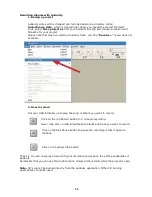
Safety Instructions
•
Read Instructions - All the safety and operating instructions should be read before the appliance is operated.
•
Retain Instructions - The safety and operating instructions should be retained for future reference.
•
Heed Warnings - All warnings on the appliance and in the operating instructions should be adhered to.
•
Follow Instructions - All operating and use instructions should be followed.
•
Water and Moisture - Th e appliance should not be use d near water - for example, near a bathtub, wa shbowl,
kitchen sink, laundry tub, in a wet basement, or near a swimming pool, and the like.
•
Carts and S tands - The appliance should be use d only with a cart or st and that is recomm ended by the
manufacturer.
An appliance and cart combination should be moved with care Quick stops, excessive force,
and uneven surfaces may cause the appliance and cart combination to overturn.
•
Wall or Ceiling Mounting - The appliance should be mounted to a wall or ceili ng only as re commended by the
manufacturer.
•
Ventilation - The ap pliance should be situated so that its location or p osition does not inte rfere with its proper
ventilation. For example, the appliance should not be situated on a bed, sofa, rug, or similar surface that may
block the ventilation open ings; or, pla ced in a built-in in stallation, such a s a boo kcase or cabi net that may
impede the flow of air through the ventilation openings
•
Heat - Th e appliance should be situated away from heat sources such as radiators, heat registers, stoves, or
other appliances (including amplifiers) that produce heat.
•
Power S ources - Th e a ppliance should be connected to a po wer supply o nly of the type de scribed in the
operating instructions or as marked on the appliance.
•
Grounding or Pola rization - Precautio ns should b e t aken so th at the groun ding o r p olarization means of an
appliance is not defeated.
•
Power-Cord Protection - Power-supply cords should be routed so that they are n ot likely to be wal ked on or
pinched by items pla ced upon or agai nst them, p aying particular attention to co rds at plu gs, conveni ence
receptacles, and the point where they exit from the appliance.
•
Cleaning - The appliance should be cleaned only as recommended by the manufacturer
Clean by wiping with a cloth slightly damp with water. Avoid getting water inside the appliance.
•
Disconnect power cord before servicing.
•
Replace critical components only with factory parts or recommended equivalents.
•
For AC line powered units - Before ret urning repaired unit to user , use an ohmmeter to measure iron b oth AC
plug badges to all exposed metallic parts. The resistance should be more than 100,000ohms.
•
Nonuser Periods - The power cord of the appliance should be unplugged from the outlet when left unused for a
long period of time.
•
Object and Liquid Entry - Care sh ould be t aken so that object s do not fall and liquids a re not spilled into the
enclosure through openings.
•
Damage Requiring Service - The appliance should be serviced by qualified service personnel when:
- The power-supply cord or the plug has been damaged; or
- Objects have fallen, or liquid has been spilled into the appliance; or
- The appliance has been exposed to rain; or
- The appliance does not appear to operate normally or exhibits a marked change in performance; or
- The appliance has been dropped, or the enclosure damaged
•
Servicing - The u ser should n ot attempt to se rvice the appliance b eyond th at described in the op era- tinge
instructions. All other servicing should be referred to qualified service personnel
.
13






































